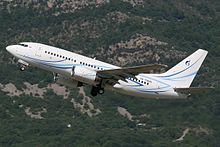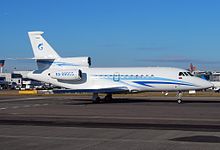Gazpromavia
| Gazpromavia | |
|---|---|

|
|

|
|
| IATA code : | 4G |
| ICAO code : | GZP |
| Call sign : | GAZPROM |
| Founding: | 3rd February 1995 |
| Seat: |
Moscow , Russia |
| Turnstile : | |
| Home airport : | Moscow Ostafiev |
| Company form: | OOO |
| Management: | Andrei Ovcharenko |
| Balance sheet total: | RUB 31.3 billion (2014) |
| Passenger volume: | 239,951 (2017) |
| Fleet size: | approx. 140 (including helicopter) |
| Aims: | national and continental |
| Website: | www.gazpromavia.ru |
Gazpromavia ( Russian : Газпром авиа) is a Russian airline based in Moscow . It is a wholly-owned subsidiary of the Russian gas company Gazprom . The home airport of Gazpromavia is Moscow 's Ostafjewo Airport .
tasks
As a subsidiary of the gas group, Gazpromavia is closely linked to its activities. One of the core tasks of the airline is the transportation of operating and security personnel for the group's large gas production projects. Scheduled flights are offered to places and settlements in the Russian north and the Far East , some of which are very small and difficult to access . The airline also names the monitoring of gas pipelines and places that are difficult to access from the air, charter flights for VIPs, air freight and search-and-rescue flights as fields of activity. In addition to direct air traffic, Gazpromavia has a maintenance center for business aircraft on the premises of Moscow Ostafjewo Airport . According to the company, it is the largest of its kind in Russia and is certified for the aircraft of the Dassault Falcon family as well as for Boeing business jets.
| year | 2010 | 2011 | 2012 | 2013 | 2014 | 2015 | 2016 | 2017 |
|---|---|---|---|---|---|---|---|---|
| Passengers | 448,607 | 373.941 | 389,652 | 386,548 | 319.496 | 292,498 | 245.025 | 239,951 |
Airports

Gazpromavia is the owner of several airports. In addition to Moscow-Ostafjewo Airport, which the company acquired in 1997, it also owns the airports in Jamburg (since 1995, around 100,000 passengers annually) and Bowanenkowo (built in 2012, capacity up to 70,000 passengers annually).
training centre
Since December 2010, the airline has had its own training and advanced training center for pilots on the premises of Moscow-Ostafjewo Airport. The center has classrooms and various flight simulators. Pilots are trained for almost all of the airline's aircraft and helicopter types.
fleet





According to its own information, Gazpromavia's fleet consists of over 30 aircraft and more than 100 helicopters from Russian, American and European manufacturers. The company does not provide precise information on the number of different aircraft and helicopters. Significantly fewer aircraft are registered for the company in the register of the Russian Aviation Agency. However, the list does not seem to be exhaustive and does not provide any information on whether the aircraft are still in active use. All information going beyond the information provided by the aviation agency is substantiated with sources. (As of September 2018)
| Aircraft type | number | annotation |
|---|---|---|
| Boeing 737-700 | 3 | a leased BBJ |
| Dassault Falcon 7X | 4th | |
| Dassault Falcon 900B | 2 | |
| Dassault Falcon 900EX EASy | 4th | |
| Yakovlev Yak-40 | 3 | Jak-40 (1), Jak-40K (2) |
| Sukhoi Superjet 100-95LR | 10 | |
| Helicopter type | number | annotation |
| Mil Wed-8 | 64 | Mi-8T (32), Mi-8AMT (15), Mi-8MTW-1 (13), Mi-8PS (2), Mi-8MTW (1), Mi-8P (1) |
| Kamow Ka-26 | 22nd | |
| Kamow Ka-226TG | 18th | |
| Mil Wed-2 | 9 | |
| Eurocopter EC 135 T2 + | 4th |
Incidents
- On March 21, 2007, a Mi-8 helicopter collided with a rock at an altitude of between 700 m and 900 m in the Komi Republic . The helicopter was on an observation flight over the Jugyd Wa National Park in the northern Urals . All five crew members and one employee of the national park were killed. After long investigations, a pilot's error was identified as the cause of the crash. He deviated from the planned route. Furthermore, the overall very inexperienced crew and difficult weather conditions had a negative impact. The helicopter was in good technical condition.
- On April 16, 2008, a Mi-2 helicopter crashed in the Perm region . Of the four people on board - two crew members and two passengers - three died.
- On January 9, 2009, a Gazpromavia Mi-171 helicopter crashed near the town of Aktash in the Altai Republic at 12:11 p.m. local time after the collision with the mountain. There were seven VIP passengers and 4 crew members on board. Four people survived the crash, including Anatoly Bannych, then Deputy Prime Minister of the Altai Republic. They were found three days after the crash. The helicopter crashed hard with the surface of the earth as the pilot tried to land the rotating helicopter quickly due to a stalled tail engine. The exact circumstances of the accident are controversial. It is alleged that unauthorized big game hunting for protected argali was pursued on the flight . Anatoly Bannych later confessed this in an interview.
- On July 22, 2009, a Mi-8 helicopter crashed on a flight near the city of Kotovo in the Volgograd Oblast . Of the eight people on board - three crew members and five passengers - six lost their lives and two were seriously injured. The cause of the crash is unclear.
- On December 19, 2009, a Mi-171 helicopter made an emergency landing 3 km from the city of Vorkuta Airport . He flew a shift team from the Yamal-Nenets Autonomous Okrug to Vorkuta. There were 22 passengers and three crew members on board. 13 people were hospitalized.
See also
Web links
Individual evidence
- ↑ The company's balance sheet for 2014. (PDF) Gazpromavia, March 2, 2015, accessed on March 26, 2016 (Russian).
- ↑ a b Russian Aviation Agency : Passenger Statistics of Russian Airlines 2016/2017. (PDF, 236 KB) Retrieved January 27, 2018 (Russian).
- ↑ Overview of the airline's fields of activity. Gazpromavia, accessed March 29, 2016 (Russian).
- ↑ a b Russian Aviation Agency: Passenger Statistics of Russian Airlines 2010/2011. (RTF) Retrieved April 16, 2016 (Russian).
- ↑ Russian Aviation Agency: Passenger Statistics of Russian Airlines 2012/2013. (RTF) Retrieved April 16, 2016 (Russian).
- ↑ a b Russian Aviation Agency: Passenger Statistics of Russian Airlines 2013/2014. (PDF) Retrieved April 16, 2016 (Russian).
- ↑ a b Passenger numbers of Russian airlines in 2015/2016. (PDF) Russian Aviation Agency, January 1, 2017, accessed February 24, 2017 (Russian).
- ^ Moscow-Ostafjewo Airport. Gazpromavia, accessed April 11, 2016 (in Russian).
- ↑ Jamburg Airport. Gazpromavia, accessed April 11, 2016 (in Russian).
- ^ Bowanenko Airport. Gazpromavia, accessed April 11, 2016 (in Russian).
- ↑ Flight School Center. Gazpromavia, accessed April 11, 2016 (in Russian).
- ^ Greetings from Alexei Miller (CEO Gazprom) on the website. Gazpromavia, accessed March 29, 2016 (Russian).
- ^ Register of Commercial Russian Airlines. Russian Aviation Agency, accessed September 12, 2018 (in Russian).
- ↑ Ka-26 of Gazpromavia. Gazpromavia, accessed March 23, 2016 (Russian).
- ↑ "Russian Helicopters" delivers 18 Ka-226TG to "Gazpromavia". ato.ru, February 25, 2016, accessed March 25, 2016 (Russian).
- ↑ Company portrait "Gazpromavia". aviaport.ru, September 6, 2012, accessed March 25, 2016 (Russian).
- ↑ Audit center risk assessment. audit-center.biz, accessed April 11, 2016 (Russian).
- ↑ Three days in hell. Moskovsky Komsomolets , June 24, 2010, accessed April 11, 2016 (Russian).
- ↑ Audit center risk assessment. audit-center.biz, accessed on April 11, 2016 (English).